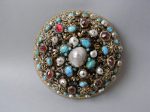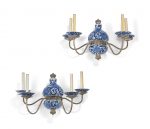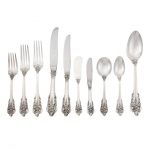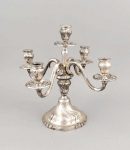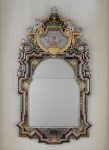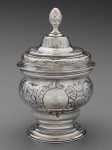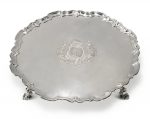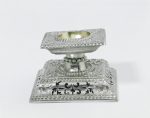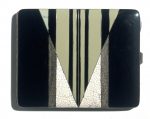Baroque is a highly ornate and often extravagant style of architecture, music, painting, sculpture and other arts that flourished in Europe from the early 17th until the mid-18th century. It followed the Renaissance style and preceded the Rococo (in the past often referred to as “late Baroque”) and Neoclassical styles. It was encouraged by the Catholic Church as a means to counter the simplicity and austerity of Protestant architecture, art and music, though Lutheran Baroque art developed in parts of Europe as well. The Baroque style used contrast, movement, exuberant detail, deep colour, grandeur and surprise to achieve a sense of awe. The style began at the start of the 17th century in Rome, then spread rapidly to France, northern Italy, Spain and Portugal, then to Austria and southern Germany. By the 1730s, it had evolved into an even more flamboyant style, called rocaille or Rococo, which appeared in France and central Europe until the mid to late 18th century. Reference: Wikipedia
Seventeenth Century Silver was very much influenced by the Huguenot silversmiths. These were refugees who leftt their French homeland because of religious persecution. English aristocrats of the time, had a love of French Style and fine craftsmanship so supported these exiles. The Huguenots, , were protected from the religious persecution of Catholic rulers until Louis XIV revoked the Edict of Nantes in 1685. In 1688 William of Orange issued a proclamation encouraging Huguenot settlement in England.
The Huguenots produced some of the finest silver items of the time having been trained in the latest French Court styles. Their skills and styles continued to influence silversmithing into the 1760s. England was an extremely prosperous nation at this time and the demand for silver increased. Silver was a way of displaying wealth and social status. Tureens and Sauce Boats were introduced during this era due to the introduction of French Cruisine. Tea, chocolate and coffee were introduced to England in the 1650s resulting in the creation of new vessels such as teapots and coffee pots.
Silver-gilt clasp (‘Heftel’), built up in several layers to form a domed shape with a large baroque pearl in centre surrounded by smaller pearls, turquoises and faceted garnets set in the centre of enamelled silver flower heads. Beneath the flowers is a domed silver-gilt plate with elaborate pierced scrollwork; an inner and outer ring of flowers is attached to this, with pearls supported on stems in between. the petal of the inner ring of flowers are enamelled in green and brown, much of it lost, while the outer ring is enamelled blue. Between the two rings of flowers are openwork foliate bosses in silver-gilt. The outer ring of flowers alternates with cast flower heads, raised on scrollwork mounts. Through the openwork decoration the gilded base plate is visible. Beneath the central pearl is a circular piece of paper which appears to be painted red with a pattern applied in gold leaf. The central pearl with claw setting; cable border at edge; pin missing. 17th cenntury
Reference: © The Trustees of the British Museum
A PAIR OF DUTCH BAROQUE-STYLE PORCELAIN AND SILVERED METAL FOUR-BRANCH WALL-LIGHTS 20TH CENTURY, SUPPLIED BY ALBERTO PINTO Each waisted blue-and-white porcelain body issuing four candle arms 13 in. (33 cm.) high; 22 in. (56 cm.) wide; 18 ½ in. (47 cm.) deep
Sold for GBP 875 at Christies in 2018
Wallace Sterling Silver Grand Baroque Pattern Flatware Service Total approximately 97 ounces, weighable.
Comprising 8 dinner forks 12 luncheon forks 11 salad/dessert forks 2 round bowl soup spoons 18 teaspoons 8 dinner knives 12 luncheon knives 3 hollow handle butter knives 8 flat handle butter knives and 1 serving spoon in a fitted case
Sold for $1,750 (includes buyer’s premium) at Doyle New York in 2018
Candelabra, German, 20th cent., hallmarked Jakob Grimminger, Schwäbisch Gmünd, silver 830/000, baroque form, round domed and slightly curved stand, vase-shaped shaft, candlestick with 4 curved arms, vase-shaped capitals, h. 37.5 cm, approx. 1650 g
Sold for €550 at Historia Auctionata in 2019
Mirror Silversmith:Johann Valentin Gevers (German, ca. 1662–1732)
This sumptuous mirror beautifully evokes the wealth of silver furnishings at the Versailles of Louis XIV (1638–1715) and, to a lesser extent, at other European Baroque palaces.
The pronounced geometric projections of the mirror’s colorful frame are typical of the South German Baroque. The feature seems to have been particularly fashionable in Augsburg, as is seen in the stepped stands of clock cases, altars, and cabinets that were also executed there. The elaborate silver and silver-gilt mounts, however, rendered in a strictly symmetrical manner, are French in character. The volutes, bandwork, acanthus foliage, tasseled lambrequin motifs, fruit and flower baskets, birds, masks, and drapery ornament appear to have been inspired by the designs of the influential French architect Jean Bérain (1638/39–1711). Bérain’s decorative style was disseminated abroad by Huguenot craftsmen who left France in 1685 after the revocation of the Edict of Nantes. Jeremias Wolff (1663/73–1724) and other Augsburg publishers sold pirated copies of Bérain’s designs during the late seventeenth century and early eighteenth century. In addition, many German silversmiths had spent several years of training abroad, often in Paris, and foreign journeymen came to work in Augsburg, stimulating the exchange of ideas and adoption of new styles.
Reference: The Metropolitan Museum of Art
Sugar bowl about 1760 Charles Allan (British, active about 1742–1763), Assayer Anthony Danvers (British, 1728–1772)
Fashionable styles like the Baroque and the Rococo became international in scope, finding expression in European colonies and other far-flung areas. Created in the latest Rococo fashion with an inverted, pear-shaped form embellished with ruffled scrolls and foliage, this bowl was made in Jamaica, a British colony.
Reference: Museum of Fine Arts Boston
A GEORGE II SILVER LARGE SALVER, GEORGE HINDMARSH, LONDON, 1735 with piecrust molded rim, engraved with later arms in figural baroque cartouche, on four scroll and shell feet marked on base diameter 16 in. 40.7 cm 54 oz 1679 g
Sold for 2,500 USD at Sothebys in 2019
Square salt with hemispherical bowl supported by a square base with pierced scrolls and frosted decoration, the bowl parcel-gilt 1692 (made)
Restrained designs for silver grew increasingly popular throughout the second half of the 17th century, possibly in reaction to the theatrical grandeur of much Baroque silver. The combination of controlled forms with pierced hearts and scrolls, matted (punched) surfaces, bands of beading and cut-card work (pierced sheets of silver applied to the surface) was typical of goldsmiths’ work around Amsterdam in the late 17th and early 18th centuries. A fine layer of gold has been applied to the bowl of this salt cellar to prevent the salt reacting with the silver.
Reference: © Victoria and Albert Museum
